Known as China’s Silicon Valley, Shenzhen is a growing city nestled between Hong Kong and mainland China. Millions of tech graduates, global corporate executives, and expert educators have been drawn to this economic, financial, and research hub. International schools have opened to accommodate expats and their families. Several of the schools highlight IB, or certain languages, but they all offer the arts.
Established in 1988, Shekou International School is the first private, co-ed school in Shenzhen. I’ve been fascinated by the work of Jeremy Van Sluytman, who teaches in Shenzhen and is a strong advocate for music education. We caught up recently.
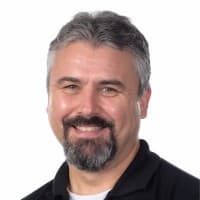
How did you become a musician and educator?
When I was about seven years old, my mother decided that my sister and I should choose a hobby to keep us occupied doing something productive. My sister chose the piano, and I chose boxing! I wanted to be the next Muhammed Ali, but my mom responded, “I’m not going to pay someone to punch my son!” After my sister started piano lessons, I copied her and slowly became obsessed. At age twelve, I discovered the guitar and aspired to play the keyboard and guitar like my hero, Eddie Van Halen. But joining a band at school was the best— I could play music I loved, and as a result, the music making led to lifelong friendships.
At age fifteen, Level 6 or 7 at the Royal Conservatory of Music, Toronto, Canada, I could play piano, guitar, bass, and percussion. But some of my friends weren’t accomplished enough to play with the bands they wanted to be in. I came upon a solution. I would tutor them! This was my first taste for teaching music. My enrollment at York University (Toronto) in the Fine Arts department and then the Harris Institute for the Arts led me to delve into recording and sound engineering—a whole new perspective for me. I recognized that my love for music could, and would, continue to evolve if I pursued new opportunities, which meant leaving Canada to seek out exciting adventures in music.
You’ve been to several countries before you decided to go to China. Where have you taught?
I first traveled to Ecuador with a drummer and songwriting partner from a band I’d played with in Canada. We had a guitar, a 4-track Tascam PortaStudio recording machine, and a lot of dreams. During our time in Ecuador, I discovered that a cousin of mine had an unusual hobby: he owned a recording studio in Venezuela. We wasted no time! I proposed to transform his studio into a business. He kind of liked the idea, so we moved to Venezuela, imagining we’d record acts in the studio. Although it was fun, it soon became clear that it wouldn’t produce enough to make it sustainable financially.
Meanwhile, I’d taken further courses in teaching English as a second language. I loved being in the classroom in Ecuador, so I decided to apply to an international school. What happened next was a turn of good luck and synchronicity that I couldn’t have imagined. The school was looking for someone to start a music program. When the international school director learned that I’d studied music, he asked if I’d be interested. This was the perfect situation for me—to combine two passions: music and teaching. The opening eventually led me to China, Kazakhstan, Indonesia, and even back to Canada for a short time.
Many of our readers might not know there are several international schools/campuses in Shenzhen. Can you tell us a bit about them and their music programs?
According to the “International Schools Database” website, there are currently 20 international schools in Shenzhen. I’m familiar with these schools through events facilitated by AMIS (The Association for Music in International Schools) and ACAMIS- ACE (Association for China and Mongolia Schools – Academic and Cultural Enrichment). We are lucky here in Shenzhen to be very close to the provincial capital, Guangzhou, as well as to Hong Kong and Macau. Several schools in each of these cities offer unique opportunities for students to study orchestral instruments, participate in Wind Band, (woodwinds, brass, and percussion instruments) and rock and jazz options, side by side with some wonderful traditional Chinese music offerings. I honestly feel students and teachers in this area are spoiled with so many opportunities to nurture their musical abilities.
That level of arts involvement is something to emulate! During your 5 years at the Shekou International School, what instruments and age groups have you taught?
I teach middle school and high school music at SIS. I’m one of two music teachers on our secondary campus (of three campuses), and within the classroom, I teach violin, viola, cello, bass (upright and electric), guitar, piano, drums and percussion, woodwinds, and brass. Students can also explore digital audio workstations. After school, I lead the strings ensemble program, even though I’m most comfortable playing guitar, piano, and drums/percussion instruments.
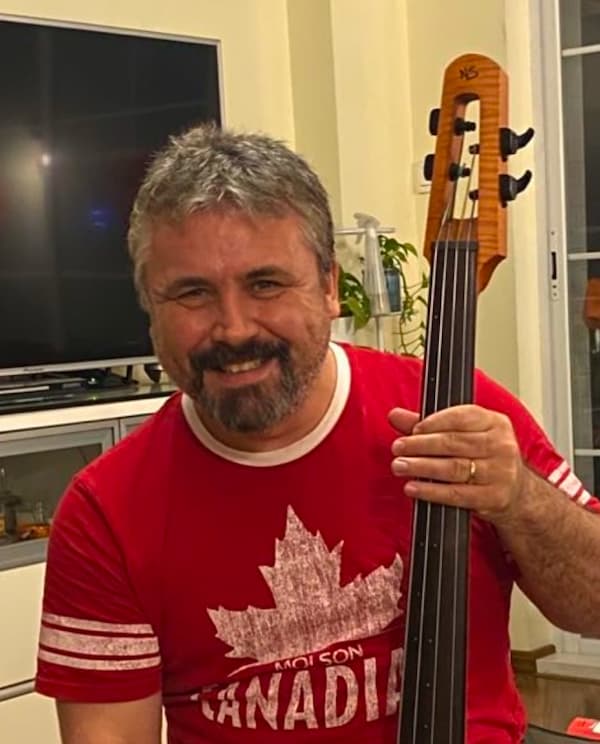
Jeremy Van Sluytman with an electric upright bass
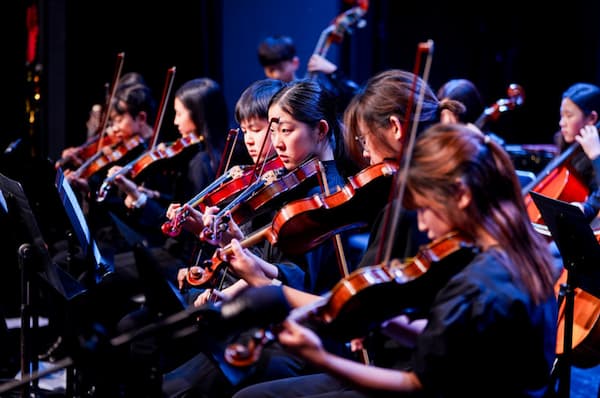
Shekou International School Strings ensemble
That’s inspiring! How many students do you have, and from which countries?
I typically have around 20 students in each class, several of whom are Korean and Chinese. We also have students from Europe, the Americas, and Oceania (comprising 14 countries). In total, our student body represents roughly 40 nationalities.
Your ambition for your students is remarkable. Recently, you had them study and play a portion of Beethoven Symphony No. 9. How did you approach this project, and how did they do?
This was certainly a “big ask” for these students. We only meet twice a week during lunch. I decided to limit our project to roughly the first 2 minutes of the second movement. I thought it would spark the students’ excitement, and would be feasible, despite the limited time we had together.
To make this possible for everyone in our group, I made arrangements for some sections. It was quite a challenge to include these simplified parts without taking away from the incredible mastery and fire of the piece. I imagine Beethoven purists may not appreciate my “meddling with a masterpiece,” but I know that because of this experience, I have roughly 20 pre-teen and teenage students who now love Beethoven and who are intent on learning more about their instruments as well as classical and romantic composers. In December, we performed the short excerpt as part of our school winter concert. It was a triumph for these young students and a joy for everyone to witness. I was so proud of their effort and commitment.
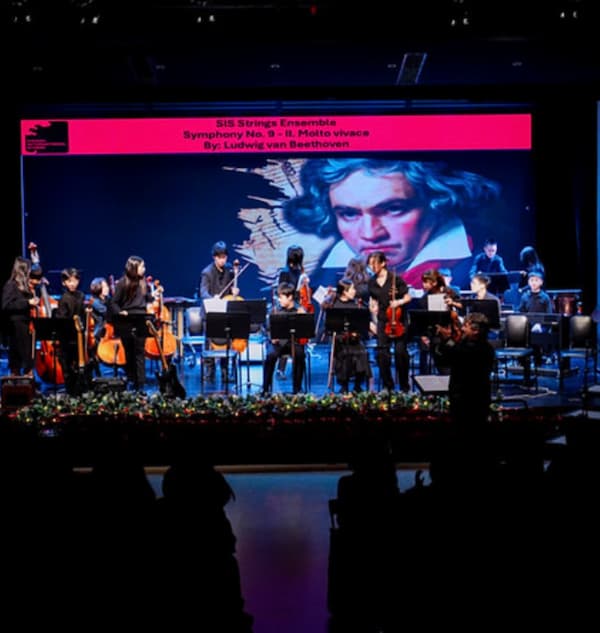
Shekou International School Strings ensemble plays Beethoven
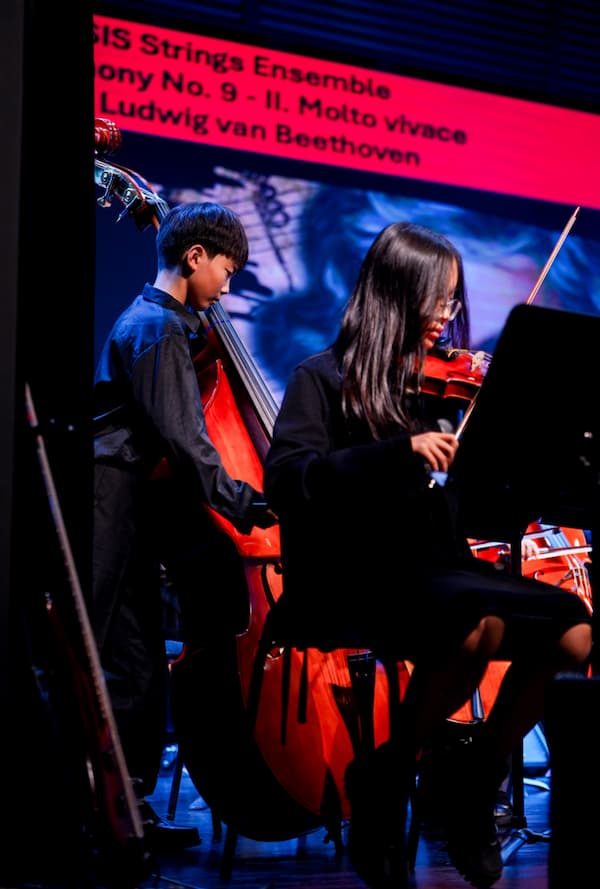
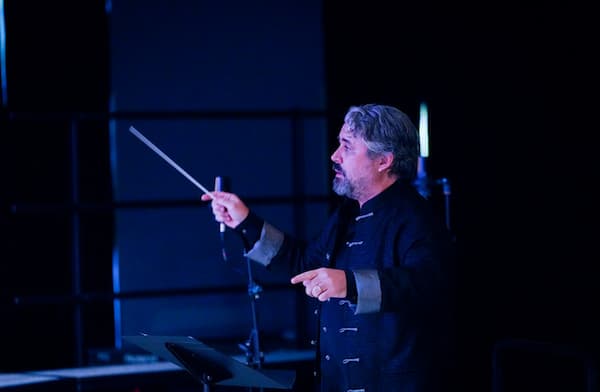
Jeremy condcuting the Strings ensemble in Dec 2024
Ludwig van Beethoven: Symphony No. 9 in D Minor, Op. 125, “Choral” – II. Molto vivace (Saarbrücken Radio Symphony Orchestra; Stanisław Skrowaczewski, cond.)
I understand you are moving to a new school. Are there opportunities and possibilities you’re looking forward to?
For the first time in my career, I’m moving on within the same city! As of August 2025, I will be teaching middle school and high school music at Shen Wai International School (SWIS).
I’m excited for new opportunities with a focus on jazz and rock music, and I’ll be working more closely with music educators whom I’ve come to know there. SWIS offers music classes up to Grade 12 and this is an extremely important plus for my son, who is a budding musician.
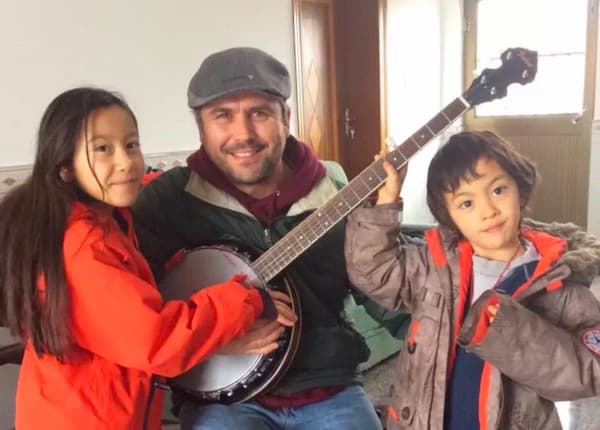
Jeremy Van Sluytman with his banjo and his daughter and son
Like SIS, SWIS is an International Baccalaureate Continuum school, accredited by the Council of International Schools and Western Association of Schools and Colleges (CIS and WASC). SWIS serves children who are residents of Hong Kong, Macau, and Taiwan of the expatriate community who work in Shenzhen.
Do visiting artists come to perform in Shenzhen?
The number of performers coming to Shenzhen, Hong Kong, and Macau has risen this year. I attended a recital by Yuja Wang, a performance by Wynton Marsalis with members of the Jazz at Lincoln Center Orchestra and the Shenzhen Symphony Orchestra at Shenzhen Concert Hall, and a concert by Herbie Hancock and friends in Hong Kong. These were all “bucket list” events for me!
Your Facebook page and site Our Mind on Music is excellent and fun. What do you hope to accomplish with it?
Thank you! That’s the goal of Our Mind on Music, to design programs that are fun for both musicians and non-musicians. When I first began Our Mind on Music about 2 years ago, I just wanted to talk with people about music without any preconceptions. I soon realized that despite countless numbers of people who love music, there’s a huge disconnect between those of us who make music and those who are in the audience. One of my main goals of OMoM is to try to bridge the gap between audiences and musicians. I hope the lighthearted approach of Our Mind on Music reduces the perception “us and them” that sometimes occurs when musicians speak about the “hows” of music. Of course, I love talking about that side of music, but as much as possible, I try to be inclusive of everyone (musician or not). With our eyes and ears open, we can all learn from each other.
Can you name some of your favourite pieces of music or composers that you’d like us to hear?
My taste is quite eclectic. Recently, I’ve become obsessed with John Coltrane’s music. The album “Giant Steps,” especially, just fascinates me.
John Coltrane: Dear Lord (arr. D. Liebman for saxophone quartet) (Aero Quartet)
For the quieter times, Erik Satie’s Gymnopédies & Gnossiennes is some of the most beautiful and calming music I’ve heard. Listen to these pieces when your soul needs some soothing.
Erik Satie: 3 Gymnopédies – No. 1. Lent et douloureux (Giacomo Scinardo, piano)
Erik Satie: 3 Gnossiennes – Gnossienne No. 1 (Giacomo Scinardo, piano)
Erik Satie: Gnossienne No. 6 (Giacomo Scinardo, piano)
I love the two quotes on your page. What do these say about music’s power?
“Music is the strongest form of magic.” – Marilyn Manson
I often refer to my students as “magic.” In a sense, the audience knows how we perform, that is, our “sleight of hand” to make music, but it remains inexplicable how our well-organized movement of soundwaves can have such a deep impact on us. Music connects us in every way: to our emotions, our communities, our cultures. In fact, when a friend and I decided to start the podcast, I was reading “This is Your Brain on Music” by Daniel J. Levitin to try to better understand how and why music affects us as it does. Our Mind on Music, the name of our podcast, is a homage to the book. I highly recommend it— an incredible read.
The second quote, “Musicians paint pictures on silence”, is attributed to the great conductor Leopold Stokowski.
One of my favourite moments in an orchestral concert is the silent anticipation just before the orchestra begins. I think this pause enhances the emotional impact when the music begins. The silence within the music enriches the piece, it gives breath, and then when we add the right amount of musical “color” or shadings in the music, it’s an exhilarating and transformative experience.
Thanks so much Jeremy. To sample Our Mind on Music, here are two excerpts of interviews including a short selection with me.
Janet Horvath on Our Mind on Music (Excerpt)
Lewis Gill on Our Mind on Music (Excerpt)
For more of the best in classical music, sign up for our E-Newsletter

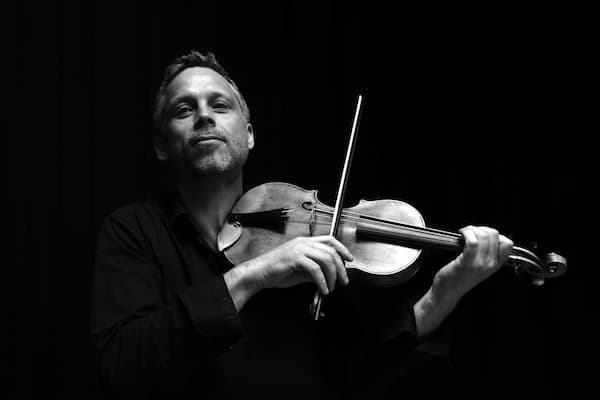
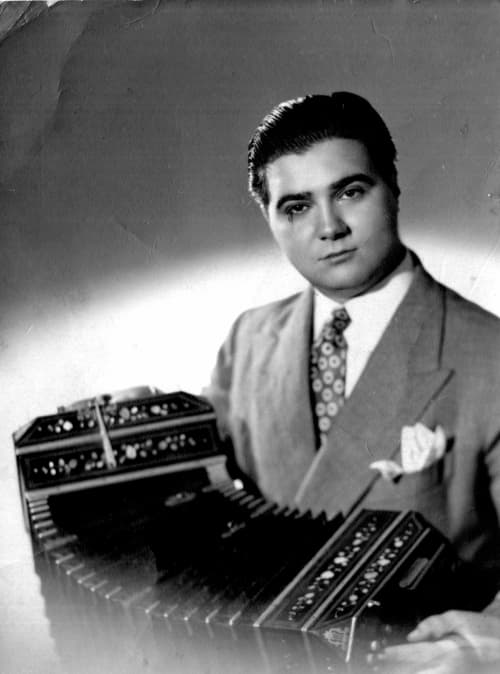
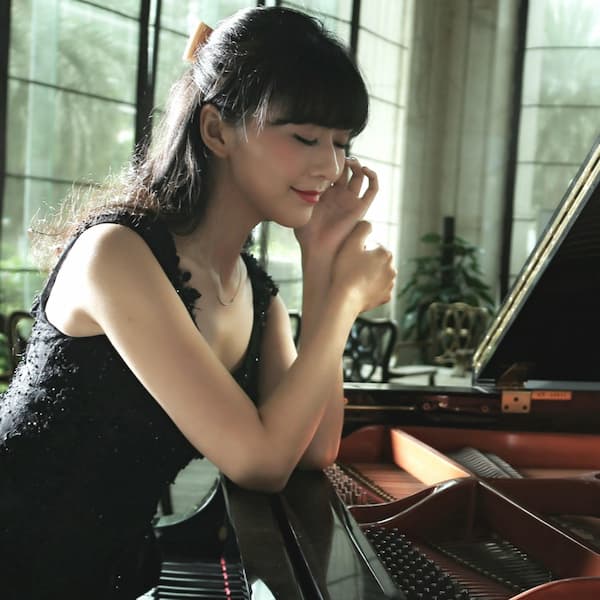
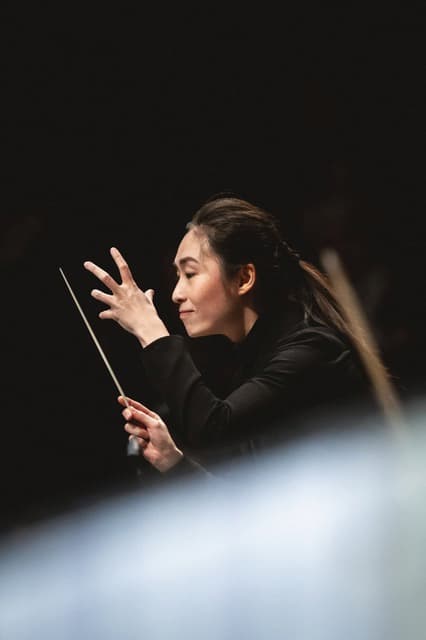
Thank you so much, Janet Horvath and Interlude, for sharing my story here. I’m truly honoured to be included in this fantastic publication.
– Jeremy Van Sluytman (Our Mind on Music)
This is a beautiful surprise, excellent interview 👏 👏👏👏. Congratulations Jeremy! Be lucky in your project👏👏👏👏
What an ambassador for music!